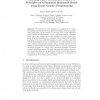Free Online Productivity Tools
i2Speak
i2Symbol
i2OCR
iTex2Img
iWeb2Print
iWeb2Shot
i2Type
iPdf2Split
iPdf2Merge
i2Bopomofo
i2Arabic
i2Style
i2Image
i2PDF
iLatex2Rtf
Sci2ools
GECCO
2003
Springer
2003
Springer
Learning Biped Locomotion from First Principles on a Simulated Humanoid Robot Using Linear Genetic Programming
We describe the first instance of an approach for control programming of humanoid robots, based on evolution as the main adaptation mechanism. In an attempt to overcome some of the difficulties with evolution on real hardware, we use a physically realistic simulation of the robot. The essential idea in this concept is to evolve control programs from first principles on a simulated robot, transfer the resulting programs to the real robot and continue to evolve on the robot. The Genetic Programming system is implemented as a Virtual Register Machine, with 12 internal work registers and 12 external registers for I/O operations. The individual representation scheme is a linear genome, and the selection method is a steady state tournament algorithm. Evolution created controller programs that made the simulated robot produce forward locomotion behavior. An application of this system with two phases of evolution could be for robots working in hazardous environments, or in applications with ...
| Added | 06 Jul 2010 |
| Updated | 06 Jul 2010 |
| Type | Conference |
| Year | 2003 |
| Where | GECCO |
| Authors | Krister Wolff, Peter Nordin |
Comments (0)

